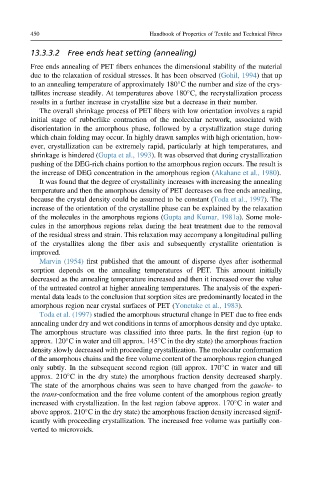Page 477 - Handbook of Properties of Textile and Technical Fibres
P. 477
450 Handbook of Properties of Textile and Technical Fibres
13.3.3.2 Free ends heat setting (annealing)
Free ends annealing of PET fibers enhances the dimensional stability of the material
due to the relaxation of residual stresses. It has been observed (Gohil, 1994) that up
to an annealing temperature of approximately 180 C the number and size of the crys-
tallites increase steadily. At temperatures above 180 C, the recrystallization process
results in a further increase in crystallite size but a decrease in their number.
The overall shrinkage process of PET fibers with low orientation involves a rapid
initial stage of rubberlike contraction of the molecular network, associated with
disorientation in the amorphous phase, followed by a crystallization stage during
which chain folding may occur. In highly drawn samples with high orientation, how-
ever, crystallization can be extremely rapid, particularly at high temperatures, and
shrinkage is hindered (Gupta et al., 1993). It was observed that during crystallization
pushing of the DEG-rich chains portion to the amorphous region occurs. The result is
the increase of DEG concentration in the amorphous region (Akahane et al., 1980).
It was found that the degree of crystallinity increases with increasing the annealing
temperature and then the amorphous density of PET decreases on free ends annealing,
because the crystal density could be assumed to be constant (Toda et al., 1997). The
increase of the orientation of the crystalline phase can be explained by the relaxation
of the molecules in the amorphous regions (Gupta and Kumar, 1981a). Some mole-
cules in the amorphous regions relax during the heat treatment due to the removal
of the residual stress and strain. This relaxation may accompany a longitudinal pulling
of the crystallites along the fiber axis and subsequently crystallite orientation is
improved.
Marvin (1954) first published that the amount of disperse dyes after isothermal
sorption depends on the annealing temperatures of PET. This amount initially
decreased as the annealing temperature increased and then it increased over the value
of the untreated control at higher annealing temperatures. The analysis of the experi-
mental data leads to the conclusion that sorption sites are predominantly located in the
amorphous region near crystal surfaces of PET (Yonetake et al., 1983).
Toda et al. (1997) studied the amorphous structural change in PET due to free ends
annealing under dry and wet conditions in terms of amorphous density and dye uptake.
The amorphous structure was classified into three parts. In the first region (up to
approx. 120 C in water and till approx. 145 C in the dry state) the amorphous fraction
density slowly decreased with proceeding crystallization. The molecular conformation
of the amorphous chains and the free volume content of the amorphous region changed
only subtly. In the subsequent second region (till approx. 170 C in water and till
approx. 210 C in the dry state) the amorphous fraction density decreased sharply.
The state of the amorphous chains was seen to have changed from the gauche- to
the trans-conformation and the free volume content of the amorphous region greatly
increased with crystallization. In the last region (above approx. 170 C in water and
above approx. 210 C in the dry state) the amorphous fraction density increased signif-
icantly with proceeding crystallization. The increased free volume was partially con-
verted to microvoids.

